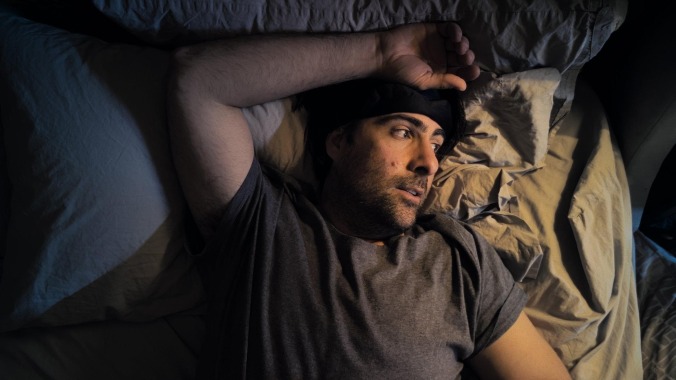There There doesn't offer much in the way of reassurance
Director Andrew Bujalski's low-key character studies, featuring the likes of Lili Taylor and Jason Schwartzman, never quite connect

American movies are usually so hesitant to depict actors of a certain age as sexual beings that it’s refreshing that the first proper scene in writer-director Andrew Bujalski’s latest relationship comedy There There is constructed around the morning after a passionate one-night stand between two fiftysomething characters. The scene begins with the positive glow of the healthcare worker (Lili Taylor) and bar owner (Lennie James) who hooked up the night before waking up and basking in their erotic chemistry. Bujalski shoots the two great character actors’ faces so we see the undimmed beauty they see in each other—Taylor’s playful, dimpled smile, and James’ disarmingly kind eyes.
Then, as the pair get out of bed and get dressed for their respective workdays, that idyllic bliss is punctured by an awkward reckoning with whether this anonymous tryst could blossom into a full-on, committed relationship. Both lovers are clearly unsure and fearful of bringing the emotional baggage of their real selves and pasts to a physical connection that might buckle under the weight of that baggage.
It’s a sharply observed, squirm-inducingly funny sequence typical of the work of indie comedy mainstay Bujalski, who began his career with ultra-low-budget, naturalistic mumblecore movies like the singularly witty Mutual Appreciation before segueing to more refined, star-powered comedies like the sweetly empowering, Regina Hall-led sports bar portrait Support The Girls. What turns out to be atypical about There There’s opening scene is that it’s one of the only six scenes that comprise the film, which is structured as a series of one-act-play-like, two-person conversational vignettes.
Half of the segments thrive on Bujalski’s knack for finding the shaggy, low-key humor in people navigating through the stresses of work and love, while the other half feel like tediously rambling sketches that didn’t go past the first draft phase of scripting leading up to production. The cumulative impact matches that of Bujalski’s Computer Chess, a similarly experimental enshrinement of ’80s computer nerd culture, in that it’s a fascinating cinematic doodle from the filmmaker that’s nevertheless so slight that it almost doesn’t register as a full-on movie.
The hit-and-miss quality of the extended, dialogue-driven sequences that make up There There is apparent when the terrific post-coital opening scene between Taylor and James is followed up by a comedically feeble one in which Taylor’s recovering alcoholic character—all of the seven central characters go unnamed—meets up with her sponsor (Annie La Ganga) to talk about the feelings that clicking with James’ bar owner stirred up within her. Once the discussion turns to an unamusing tangent about how the Taylor character’s former AA sponsor fervently believed in the existence of aliens, the segment never recovers from there.
Taylor’s reappearance in the second vignette at first seems to indicate that the film will adhere to a daisy chain structure similar to that of director Richard Linklater’s innovative debut Slacker, where one character essentially passes the narrative reins to another for each subsequent scene. But at the halfway point, that structure loosens to include a phone conversation sequence centered on two characters we haven’t met before: an ethically shady lawyer (Jason Schwartzman) and a tech-bro entrepreneur client (Avi Nash) who also happens to be one of his best friends. It’s another of the film’s standout scenes, with the reliably funny Schwartzman making the most of some choice lines from Bujalski (the character says of an overly elaborate cappuccino machine, “I’m not trying to own a fucking Ferrari. I’m just trying to stay awake a little bit and get some enjoyment out life.”). However, it’s then followed by a supernaturally tinged segment that wears out its welcome after just a couple of minutes, in keeping with the movie’s constantly shifting rises and dips in quality.
One unifying element tying the sequences together is the interconnectedness between the characters that becomes more apparent as the film goes on, and another thing the vignettes unfortunately have in common is a bland visual aesthetic based on alternating, shot/reverse shot close-ups of the two people talking in each scene. It’s only fair to acknowledge that, according to the film’s press notes, this visual approach arose out of COVID-era necessity—each actor was shot by themself and then only brought together with a scene partner in editing. But that does little to assuage how numbing the repetitive close-up compositions become.
Composer Jon Natchez, best known as a member of the band The War on Drugs, appears onscreen not just at the very beginning, but also between each of the isolated episodes, each time offering a musical performance that acts as a sort of palate cleanser. For one of his solo performances, he resourcefully makes rhythmic music out of slapping a couple of spoons against a cereal bowl. It’s a neat metaphor for how Bujalski himself is trying to create art with the spare tools he’s left with in the wake of production limitations. If the resulting film feels like little more than the cinematic equivalent of a series of B-sides of varying quality strung together, it at least whets the appetite for the next proper cinematic album that Bujalski releases.